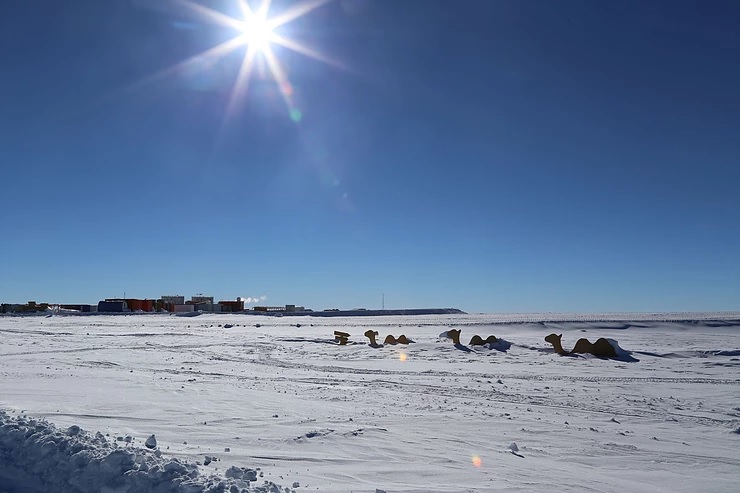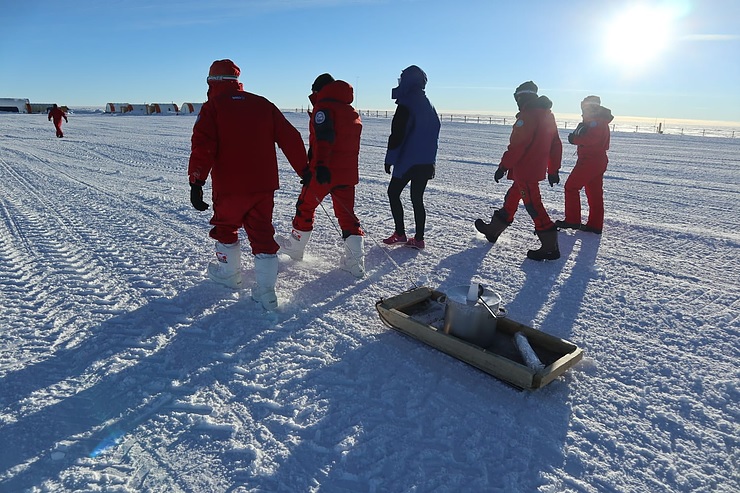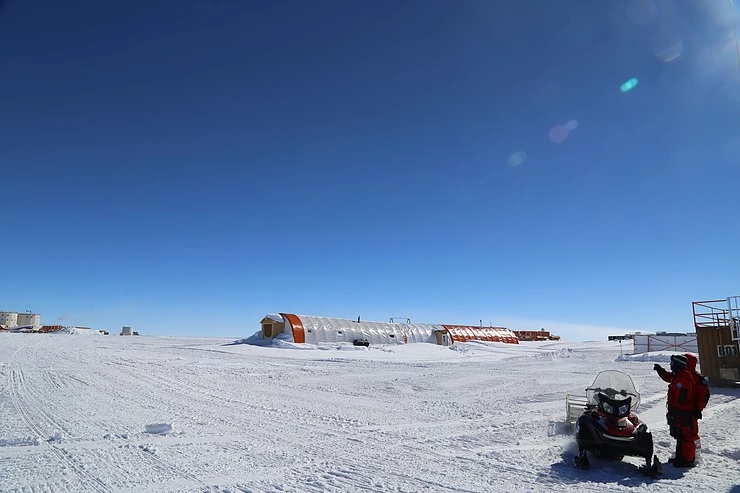Dr. Nadja Albertsen is the ESA-sponsored medical doctor spending 12 months at Concordia research station in Antarctica. She facilitates a number of experiments on the effects of isolation, light deprivation, and extreme temperatures on the human body and mind. In the following post, Nadja walks us through a day in the life of Concordia.
The difference between being inside and outside in Concordia is almost overwhelming. When you sit in the laboratory, which I have done most of the day today, you quickly forget that you are not in Aalborg, Denmark, – or any other place with chairs, coffee cups and an infinite number of test tubes and pipettes. But a look out the window tells another story. The white landscape seems almost artificial when viewed through a small window with two solid glass panes and a layer of ice at the bottom of the frame between them.
Some of my colleagues are struggling with headaches. Many have symptoms of altitude sickness due to the rapid increase in height of the journey – from 0 meters to 3400 meters. Most people get headaches, become dizzy, nauseous, and breathless, but often get over it in a few days. Altitude sickness can become serious, as it can cause fluid build-up in the lungs or the brain – but it is extremely rare.
We get the order to take it easy the first few days, so after arrival much of our time is spent looking out of the window. I am fine – no symptoms of altitude sickness, but over the last few days my skin has become extremely irritated by the dry air. My eyes run like a faucet. The mucous membranes in my neck and nose are irritated and my nose is puffy. All in all, I make a charming Antarctic sight.
The ESA laboratory is small, a bit crowded, and of course full of stuff. Like every other room in Concordia, it reminds me of the “cheese” pieces in Trivial Pursuit.
Getting things transported to Antarctica is challenging (and expensive) so you need to be sure you can go without a few things if need be. And it is clear that over the years several research teams stocked up on things. The cupboards abound!
And when the Antarctic summer opens up for transport of new staff, carrots and pumpkins, and bacon, the ESA laboratory is also restocked – and it so happened this time that bottles with buffers or the like were exposed to frost and exploded in the boxes, which makes the unpacking a little more exciting.
I go on a small treasure hunt for things that were put away last year and now need to be used again. Each year ESA accepts applications from researchers wishing to carry out projects at Concordia and then selects a specific number. Some projects run for several consecutive years. Sometimes fewer participants than expected sign up, meaning some projects have to skip a year. Materials from these projects remain on the base but are saved in strategic places, as it is not the most frost-free space.
Above the “front door” is a screen where the current weather is displayed – temperature, windchill, wind conditions and humidity. Currently, the temperature fluctuates between –40 °C and –50 °C which feels a little cooler with the usual 2-3 second per meter wind. The humidity is constantly around 40%, which makes it seem warmer than expected, but also makes your lips crack. But outside the sun warms you up surprisingly well, and in my blue winter suit, I am more comfortable than I expected.
Sometimes I hear the buzz from snowmobiles or the larger vehicles that transport goods from the plane or dig around the summer camp, which must be made ready for the wave of scientists arriving soon.
The summer camp is located approximately 1 km from Concordia and consists of a number of solid tents, which have inlaid water, and an espresso machine and washing machine. There is even internet, like anywhere else on the base, to communicate with the outside world.
Inside, the beds are ready, but a layer of cold covers it all. Soon we will no longer be 30 but 80 people, and the base is going to be buzzing with life. I get a guided tour around with the snowmobile and see the EPICA cave from the outside.
I am allowed to stroll the nearly 2 km back to the base with the camera over my shoulder. It gives more time to take it all in. I am warm and comfortable in my air suit, two ski masks, hat, ski goggles and a pair of electrically-heated gloves supplemented with a pair of shell gloves, and of course the boots.
It is difficult to describe the landscape. Some of you may have been on the Greenland ice sheet and you get the same feeling of infinity there as you do here. It is a luminous white with curves towards the horizon under the nose of turquoise blue sky. But otherwise there is nothing. No sounds, no animals. No smell. White Mars.
A tour of the base with the station manager leads us past the water purification plant. The drinking water at Concordia is melted snow, which is picked up at a cut away from the base. The drinking water that runs in the sink passes the water treatment plant and is recycled as water in the toilet or showers. The shower water is cleaned again and reused, while toilet water and water from certain washes end up as “black water” and is not reused. Much is compressed so that it can be sent back to Australia – and if it is not properly sorted, fines are imposed. Organic waste, on the other hand, ends up composted, which reduces the volume by 90%. All in all, approx. 85% of the water is recycled.
There is a slight, indeterminate smell in Concordia that apparently originates from a time when they burned faeces. There is still a single toilet system like this in case of emergencies.
Back to my treasure hunt. I end up spending most of the day marking vials so they are ready for use when the others come. I also go through a couple of boxes of content, where it turns out that some have expired and others have exploded and I have to email the researcher who is responsible for the project with the unfortunate news.
And in the corner under a blanket lurks a CT scanner that I’ll give test out tomorrow. It will be interesting.
To read Nadja’s adventures at Concordia in Danish, see her personal blog.








Discussion: no comments